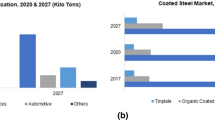Abstract
The automotive customers have been down-gauging steel sheets for making door panels to reduce weight of the passenger cars and improve fuel efficiency under “Go Green” initiative. Tata Steel has been extending support in weight reduction initiative of the automakers through supplying thinner gauge interstitial free (IF) steel sheets. It was reported that in some cases, the thinner sheets could not withstand the intricate forming and stretching operation and resulted in pin-dent or press crack defect generation in deep drawn areas of the components. The defect was reported for the first time to TSL by auto customer, and in the sense, it was a unique defect. At times, the defect impacted 20–40% of deep drawn door components and led to a near line stoppage situation in the press shop. Representative samples containing the defects were collected from the site, and detailed investigation was carried out employing metallographic techniques such as scanning electron microscope (SEM) attached with energy-dispersive x-ray analysis (EDX). The investigation revealed non-metallic inclusions (NMI) to be the cause of such defects. A thorough process and data analysis was carried out to identify the sources of such inclusions and arrive at appropriate countermeasures to fix this problem. Subsequently, countermeasures were implemented in the steel manufacturing process, and such pin-dent defects were eliminated bringing much respite to the customer. The paper will highlight the systematic approach in dealing with the problem and successful resolution of the intriguing quality issue.












Similar content being viewed by others
References
T.K. Roy, S. Basu, S. Suresh, V.V. Mahashabde, Continuous slab casting—a journey of two decades at Tata Steel. Steel Tech 5, 23–28 (2011)
S. Suresh, T.K. Roy, R. Ranjan, J.B. Singh, C. Bhanu, V.V. Mahashabde, Production of interstitial free steel—a decade long journey at Tata Steel. Tata Search, 181–185 (2011)
N. Johnston, Examination of small crack defects. Internal Report, Tata Steel Europe, (2012)
S. H. Nam, O. D. Kwon, D. W. Yang, M. R. Kim, H. B. Lee, J. I. Kim and B. D. You, in 78th Steelmaking Conf. Proc., ISS, Warrendale, PA, 551 (1995)
M. Hashio, N. Tokuda, M. Kawasaki and T. Watanabe, in Continuous Casting of Steel, Secondary Process Technology Conf., Vol. 2, ISS, Warrendale, PA, 65 (1981)
S. Nakai, Tatsuo Kanai, Yoshihiko Higuchi, Sei Hiraki, Ultar low carbon steel sheet. US Patent, US 6726782 B2, April (2004)
J. Sengupta et al., Direct measurement of sub-meniscus velocity at Arcelor Mittal Dofasco’s No.1 continuous caster to evaluate mould fluid flow at different casting conditions. AISTech, 1697–1706 (2011)
Q. Zhang, L. Wang, X. Wang, Influence of casting speed variation during unsteady continuous casting on non-metallic inclusions in IF steel slabs. ISIJ Int. 46(10), 1421–1426 (2006)
L. Qiaotong, R. Yang, X. Wang, J. Zhang, W. Wang, Water modeling of mould powder entrapment in slab continuous casting mould. J. Univ. Sci. Technol. Beijing 14(5), 399–404 (2007)
Acknowledgment
The authors would like to thank personnel from Tata Steel Europe and NSSMC for the valuable discussions during the investigation of pin-dent defects. Thanks are also due to the TSL teams from Scientific Services for defect analysis and LD2&Slab Caster for carrying out trials with suggested corrective actions to overcome this defect. Sincere appreciation and thanks are due to our esteemed customers who facilitated and helped in carrying out different set of trials in resolving this quality problem. Finally, authors would also like to thank Tata Steel Management for giving permission to publish this work.
Author information
Authors and Affiliations
Corresponding author
Additional information
Publisher's Note
Springer Nature remains neutral with regard to jurisdictional claims in published maps and institutional affiliations.
Rights and permissions
About this article
Cite this article
Roy, T.K., Balakrishnan, V. & Suresh, S. A Study on the Resolution of Pin-dent Defects in Automotive Door Panels. J Fail. Anal. and Preven. 21, 518–524 (2021). https://doi.org/10.1007/s11668-020-01085-4
Received:
Revised:
Accepted:
Published:
Issue Date:
DOI: https://doi.org/10.1007/s11668-020-01085-4




